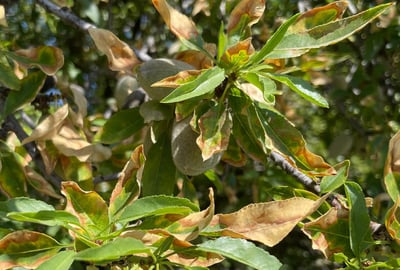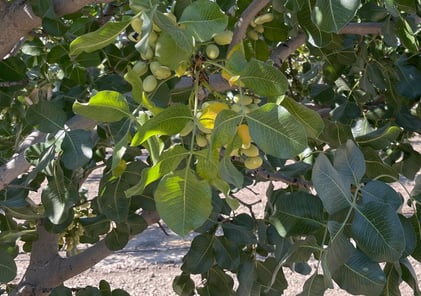Leaf Tissue Testing in Tree Crops: Importance and Considerations


Nutrient deficiency or excess will cause trees to grow poorly affecting yield and fruit quality. For this reason, diagnosing potential nutritional problems through leaf analysis will help adjust fertilization programs so that nutritional problems and their costly consequences are prevented. Leaf analysis provides information on the actual status of the tree and the efficiency of management decisions being an important tool to help evaluate how effective a fertilization program is. Therefore, leaf testing should be a yearly routine tree-growing practice.
When summer leaf levels show the orchard is deficient, yield will suffer the following year. Do not get behind in your fertility program. Photo: Potassium deficiency in almonds.
Importance of Leaf Tissue Testing
Plant tissue testing is extremely important to help identify hidden nutrient toxicities and deficiencies when visible symptoms are not present. Leaf tissue testing is, therefore, a useful guide to monitor your nutrient management program and to identify an uptake problem. It is the only way to detect “hidden hunger”, when mild nutrient deficiencies may not produce obvious visual symptoms, like leaf yellowing or chlorosis, but can have a huge impact in crop yield. Usually if nutrient deficiency symptoms are present, it has already caused yield damage.
Leaf Sampling Considerations
It is extremely important to do leaf sampling properly to get meaningful comparisons and interpretations. If it is all done properly, fertilization recommendations and fertilizer program adjustments will be sound. Sampling should be done carefully from the time leaves are selected in the field to the time they are received at the laboratory for analysis. If any steps in sampling or analysis are faulty, the results may be misleading.
Timing is very important, nutrient concentrations in the leaves continuously change. As leaves get older, depending on the nutrient, concentration may increase or decrease. In addition, nutrient content can vary regarding leaf location in the tree canopy but also between fruiting and non-fruiting branches. In pistachios for example, nitrogen concentration in a fruiting branch can be as low as 2% and in a non-fruiting branch it can be as high as 2.6%.
In general, nutrient concentrations are relatively stable from four to six months after leaf emergence in the spring and as a result, the best time to collect leaves is July and August. It is important that trees should be of the same age, scion type and rootstock. If samples are being taken for diagnosing any growth disorder within the orchard, samples should be collected from both affected and nonaffected trees for comparisons. In these specific cases, samples can be taken at any time of the year.


Leaf Sampling Protocol
For most tree crops, each sample should represent an area that is not bigger than 20 acres. It is recommended to sample at least 100 leaves taken from non-fruiting branches of 15 to 20 uniform trees of the same variety and rootstock. Trees should be at least 25 yards apart. When sampling, consistency is very important, and the selected trees should be representative of the average within the block being sampled. For example, sampling young leaves is not recommended because they change composition very quickly. Trees at the edge of the block or at the end of rows should not be sampled either as well as diseased, insect-damaged, or dead leaves.
After collecting the samples, the leaves should be washed by hand soon after collection to remove any soil particles and dust. The samples should then be stored in paper bags, never in plastic bags, and kept at room temperature until delivery to the lab. Another option is to dry the leaves in a ventilated oven at about 140°F. If you cannot deliver the samples to the lab in the same day or if you cannot wash or oven-dry you can place them in a fridge for overnight storage or until you deliver it to the lab.
Sampling leaves from fruiting branches is not recommended due to high demand from fruits for nutrients leading to variable leaf nutrient concentrations.
Consistency is Critical
Leaf analysis should be done annually. However, it is important to keep in mind that leaf analysis alone is not a clear-cut tool. To make sound fertilizer decisions, growers should use all tools available. Leaf, soil, and water reports are mandatory to help make decisions when stablishing any fertilization program. In mature orchards, trees should always be fertilized according to yield potential of current year. Therefore, monitoring your orchard regularly is key. The wise use of all resources, knowing the current field conditions and field history will help growers not only to optimize production but also minimize fertilizer losses.
